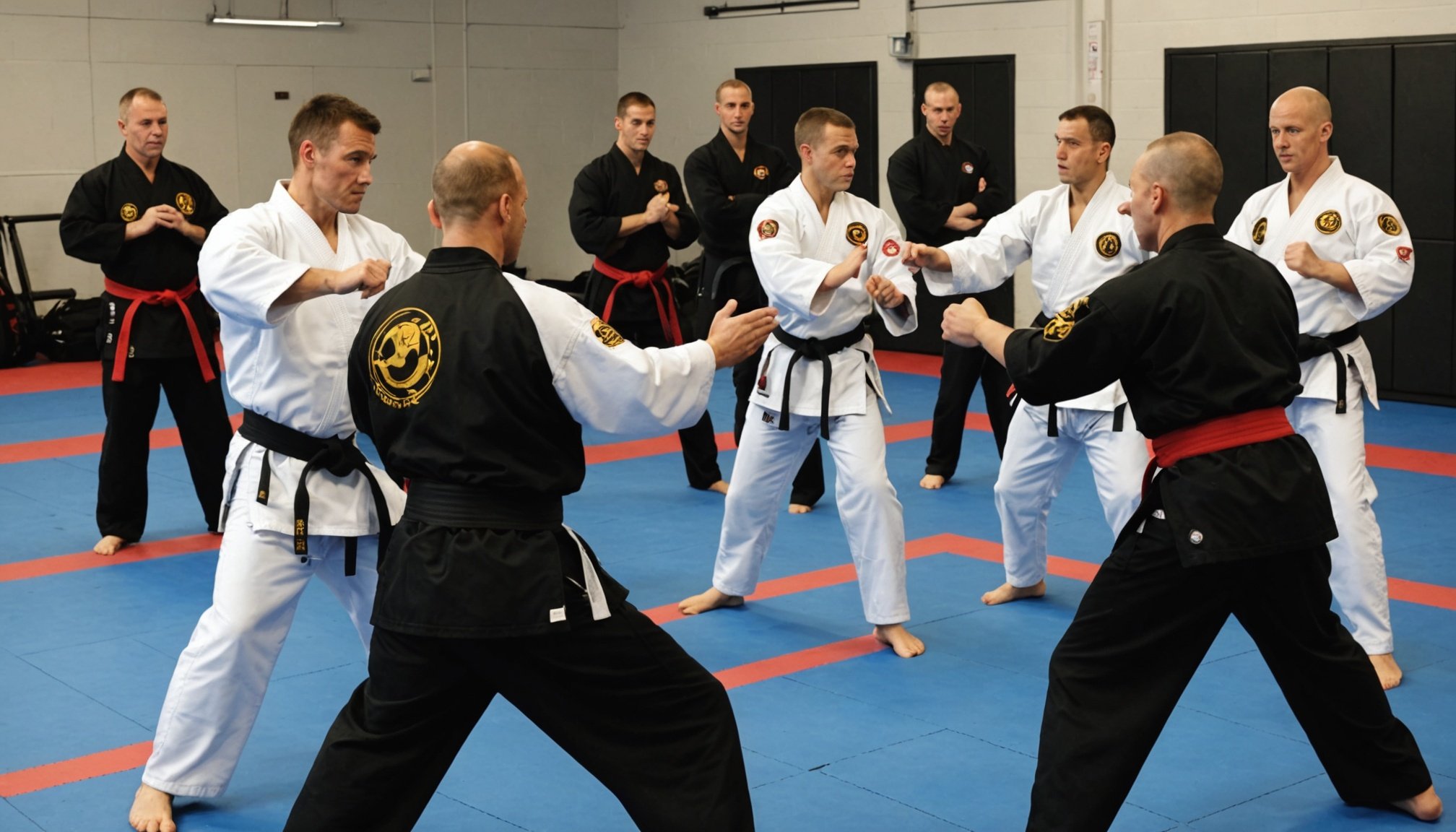Instructors managing large groups face unique challenges. Mastering class control not only enhances students' experience but also boosts instructors' confidence. Effective strategies can transform chaos into harmony, fostering engagement and discipline. This guide offers practical insights tailored for UK martial arts instructors, helping you connect with your students and create a thriving environment. Develop skills that turn challenges into opportunities for growth. Discover how to excel in your classes while building a strong community of martial artists.
Understanding Class Control in Martial Arts
Effective class management is crucial for martial arts instructors to maintain a productive learning environment. Instructors need to implement solid martial arts control strategies to ensure that students are engaged and disciplined. This becomes particularly important when managing large groups, where maintaining focus and safety can be challenging.
Have you seen this : Ensuring Fairness: Strategies for UK Combat Sports Referees in Evaluating Matches
Martial arts classes often involve diverse age groups and skill levels, requiring instructors to adapt their teaching methods accordingly. In the UK, martial arts classes may have unique dynamics due to cultural diversity and varying levels of experience among students. This diversity can enrich the learning experience but also demands a higher level of adaptability from instructors.
Challenges in managing large groups include ensuring that all students receive individual attention while maintaining a cohesive class structure. Instructors must balance teaching new techniques with reinforcing discipline and respect among students.
Topic to read : Ultimate Hydration Strategies for Intense Martial Arts Training in the UK
To address these challenges, instructors can employ strategies such as setting clear expectations, using positive reinforcement, and structuring classes with a mix of individual and group activities. By doing so, they can enhance their effectiveness and provide a supportive environment for all students to thrive.
Ultimately, mastering class control not only benefits students but also enhances the instructor's ability to teach effectively and manage their class successfully.
Engaging Students in Large Classes
Effectively capturing students' attention in a crowded martial arts class requires deliberate student engagement strategies. One approach is to incorporate interactive elements that not only boost participation but also maintain focus. Techniques such as call-and-response exercises or group drills can be particularly effective. These methods encourage active involvement and ensure that each student feels included, even in a large group setting.
Building rapport and a sense of community is essential to further enhance engagement. Instructors can achieve this by fostering an environment where students feel comfortable and valued. Simple actions, like learning students' names and acknowledging their progress, can significantly impact their motivation and willingness to participate. Additionally, creating opportunities for peer interaction, such as partner exercises, helps students connect with one another, strengthening the class's overall cohesion.
Further, diversifying the class structure with varied activities keeps students engaged and attentive. Alternating between individual tasks and group challenges can cater to different learning styles and prevent monotony. By implementing these strategies, instructors can ensure that all students remain engaged, making the learning experience enriching and effective for everyone involved.
Establishing Discipline in Class
Creating a disciplined environment in martial arts classes is essential for effective classroom management. Setting clear expectations for behaviour and participation from the outset helps establish a framework within which students can thrive. Instructors should communicate these expectations consistently to ensure students understand the importance of discipline in their martial arts journey.
When addressing disruptive behaviour, it is crucial to employ effective methods that maintain the class's integrity while guiding students back on track. One strategy is to address issues immediately and privately, allowing the student to correct their actions without public embarrassment. This approach maintains respect and encourages self-reflection.
Reinforcing positive behaviour is equally important. Techniques such as positive reinforcement can be highly effective in promoting desired actions. Acknowledging students' efforts and achievements, whether through verbal praise or small rewards, can foster a positive atmosphere and motivate students to maintain high standards.
Incorporating discipline techniques into the class structure can also help. For example, starting and ending each session with a structured routine reinforces discipline and sets a consistent tone. By implementing these strategies, instructors can create a disciplined, respectful, and engaging learning environment for all students.
Safety Protocols for Large Groups
Ensuring safety in martial arts classes, especially with large groups, is paramount. Instructors must prioritise risk management to create a secure environment. Key safety considerations include assessing the training space for hazards, ensuring equipment is in good condition, and maintaining a manageable student-to-instructor ratio.
Developing comprehensive emergency procedures is essential. Instructors should establish protocols for common injuries or incidents, ensuring that all staff are familiar with these procedures. Regular drills can help reinforce these measures, ensuring a swift response if an emergency arises.
Educating students on safety practices is also critical. Instructors can integrate safety education into their lessons, teaching students how to correctly use equipment and execute techniques safely. Emphasising the importance of personal space and awareness can prevent accidents, especially in crowded classes.
Instructors might consider implementing the following strategies:
- Conduct regular safety briefings.
- Encourage students to report unsafe conditions.
- Foster a culture of mutual respect and awareness.
By focusing on these aspects, martial arts instructors can effectively manage safety in large classes, ensuring a positive and secure learning experience for all students.
Utilizing Assistant Instructors Effectively
Incorporating assistant instructors into martial arts classes can significantly enhance class management and student engagement. These individuals provide vital support, allowing the lead instructor to focus on delivering quality instruction. By adopting effective delegation strategies, the workload can be distributed efficiently, ensuring all students receive the attention they need.
Training assistant instructors is crucial for their successful integration. Comprehensive assistant instructor training should cover not only technical skills but also communication and leadership abilities. This preparation ensures that assistants can effectively support the lead instructor and manage small groups or individual students when necessary.
Balancing authority and collaboration is essential in this dynamic. While assistant instructors should respect the lead instructor's authority, they must also feel empowered to contribute to the class. Open communication and regular feedback sessions can foster a collaborative environment where both lead and assistant instructors work harmoniously.
Key benefits of involving assistant instructors include:
- Enhanced student support and engagement
- Improved class structure and flow
- Opportunities for assistants to develop teaching skills
By utilizing assistant instructors effectively, martial arts classes can maintain high standards of instruction and provide a more personalized learning experience for students.
Adapting Teaching Styles for Diverse Groups
In martial arts classes, recognising varied skill levels and learning styles is vital for effective instruction. Instructors should employ differentiated teaching methods to cater to the diverse needs of their students. This approach ensures that each student receives the appropriate level of challenge and support, promoting a more inclusive learning environment.
Adapting drills and exercises is one way to achieve this inclusivity. By modifying techniques to suit different abilities, instructors can ensure that all students are engaged and progressing. For example, a basic kick can be taught with varying levels of complexity, allowing beginners to focus on form while advanced students refine their technique.
Providing individualised feedback within a group setting is another crucial aspect. Instructors can use specific strategies to address each student's unique needs. This might include offering verbal cues during practice or demonstrating alternative methods for those struggling with a particular move. Such tailored feedback helps students improve their skills and fosters a sense of accomplishment.
By implementing these differentiated instruction techniques, martial arts instructors can create a supportive and dynamic learning environment. This approach not only benefits students but also enhances the overall class experience.
Incorporating Technology in Class Management
Incorporating technology in martial arts classes can greatly enhance class management tools and overall efficiency. Instructors can utilise various tools and apps for scheduling and communication, streamlining administrative tasks and keeping everyone informed. Platforms like TeamSnap or Google Calendar help manage class schedules, send reminders, and communicate changes effortlessly.
Utilizing video analysis is another powerful method to aid student improvement. By recording sessions, instructors can provide visual feedback, allowing students to observe their techniques and make necessary adjustments. Apps like Coach's Eye or Dartfish offer features that enable slow-motion playback and detailed analysis, facilitating a deeper understanding of martial arts techniques.
Engaging students through online resources and platforms can further enrich their learning experience. Platforms such as YouTube or specialized martial arts websites provide a plethora of instructional videos and tutorials. These resources can supplement in-class learning, offering students additional practice opportunities outside the dojo. Additionally, creating a class-specific online community, perhaps through a private Facebook group, encourages interaction and knowledge sharing among students, fostering a sense of camaraderie.
By integrating technology, martial arts instructors can enhance their teaching methods, improve student engagement, and streamline class management, ultimately creating a more dynamic and effective learning environment.
Building a Supportive Community
A thriving martial arts community is pivotal in fostering an environment conducive to effective class management. Instructors can benefit immensely from the collective wisdom and shared experiences within this community. Networking with fellow instructors allows for the exchange of shared strategies that can enhance teaching methods and improve class dynamics. By participating in workshops, seminars, or online forums, instructors can gain fresh insights and innovative techniques that they might not have encountered otherwise.
Access to instructor resources is another significant advantage of being part of a martial arts community. These resources, which may include training manuals, instructional videos, or mentorship programs, provide valuable support for ongoing professional development. They equip instructors with the tools needed to adapt their teaching styles and effectively manage diverse groups of students.
Moreover, community support extends beyond just resources and networking. It fosters a sense of belonging and encouragement among instructors, motivating them to continually refine their skills. Engaging with a martial arts community not only enriches an instructor's personal growth but also positively impacts their students' learning experiences. By leveraging these community connections, instructors can create a more supportive and dynamic class environment.
Real-life Examples from Experienced Instructors
Learning from instructor testimonials provides valuable insights into effective class management. Consider the case of Sensei Mark, who successfully manages large martial arts classes in London. He emphasises the importance of clear communication and structured routines. His approach includes setting precise expectations at the start of each class, which helps students understand their roles and responsibilities.
Another practical example comes from Master Lisa, who teaches a diverse group of students. She has found success by incorporating cultural elements into her lessons, making them relatable and engaging. This strategy not only enhances student interest but also fosters a sense of community within her classes.
Seasoned instructors often encounter challenges, such as maintaining discipline in large groups. Sensei Tom shares his experience of using positive reinforcement to address this issue. By acknowledging students' achievements, he creates a motivating environment that encourages good behaviour and active participation.
Lessons learned from these instructors highlight the importance of adaptability and innovation in class management. By applying these practical examples, instructors can enhance their teaching methods, ensuring a productive and supportive learning atmosphere for all students.
Continuous Improvement and Feedback Mechanisms
In the realm of martial arts instruction, the pursuit of excellence hinges on effective feedback strategies and a commitment to continuous improvement. Seeking feedback from both students and assistant instructors is crucial for personal and professional growth. By actively engaging with students, instructors can gain insights into their teaching effectiveness and identify areas for enhancement. This dialogue fosters a culture of openness and encourages mutual respect.
Methods for Self-Assessment
Implementing self-assessment techniques allows instructors to reflect on their teaching practices. Regularly reviewing class sessions, either through video recordings or personal notes, can highlight strengths and pinpoint areas needing adjustment. This reflective practice is an invaluable component of instructor development, enabling educators to refine their approach and better meet the needs of their students.
Setting Goals for Growth
Establishing clear goals is essential for sustained improvement. Instructors should set both short-term and long-term objectives, focusing on specific skills or knowledge areas they wish to develop. This goal-setting process not only provides direction but also motivates instructors to continually enhance their capabilities. By embracing these feedback mechanisms, martial arts educators can ensure they remain effective and adaptable, ultimately benefiting their students' learning experiences.











